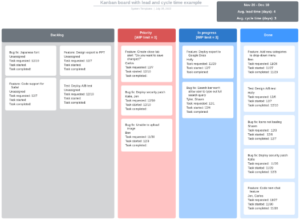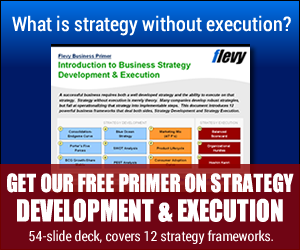Kanban is a great approach for visualizing progress in initiatives involving rapid change. It also provides a foundation for continuous process improvement by executing teams.
This post provides an overview of Kanban, the key elements of Kanban boards, and the impact and usefulness of Kanban to strategy and project management.
What Is the Kanban Project Methodology?
 Kanban originated in the 1940s as an approach to workflow. It is a technique usually practiced by scrum teams.
Kanban originated in the 1940s as an approach to workflow. It is a technique usually practiced by scrum teams.
A simple Kanban board is shown at right.
The most well-known origins of Kanban were in Toyota’s approach to manufacturing. A key tenet of the approach is that each process step is a customer of preceding steps in the process. The idea is to balance demand and production at each step.
Kanban boards are best known for the fact that they provide a visual signal of a change in the system – a signal which triggers demand to refill or clean out a column to re-balance the system. The steps in the process are kept in balance – or if they become out of balance, the process team analyzes and takes action – ‘swarms’ – to rebalance the system.
In practice, Kanban has become more than a method; it has become a system of values characterized by a notable lack of rules. The values emphasize respect for people and a culture of continuous improvement. This has all enabled Kanban to broaden in application from manufacturing to other areas, such as software.
David Anderson defined the ‘Kanban method’ – an approach for bringing Kanban into the realm of software and services. He established five components of Kanban:
- Visual Signals
- Columns
- Work-In-Progress (WIP) Limits
- A Commitment Point
- A Delivery Point
Let’s dive deeper into each of these components of David Anderson’s approach.
Kanban Board Component #1: Visual Signals
 The basis for activity on the Kanban board is ‘Visual Signals’. This refers to status for the items on the Kanban board. Typically, work items are written onto cards – physically or virtually.
The basis for activity on the Kanban board is ‘Visual Signals’. This refers to status for the items on the Kanban board. Typically, work items are written onto cards – physically or virtually.
Each card represents a visual signal, particularly when it is moved. The cards are highlighted in blue in the Kanban board at right.
Cards represent a work item. For agile teams developing software, the cards would represent a user story. The user story represents a work item that can be accomplished in a ‘short’ period – usually one or a few days, and no more.
The cards are then transferred through the process steps, represented by the columns. The movement of a card provides the visual signal. Visually, the team can see where in the process the card is, based upon the column where it is placed.
Kanban Board Component #2: Columns
 The columns on the Kanban board indicate a particular process step, or activity in the workflow. In its simplest form, the Kanban board might have three columns: To Do, In Progress, and Complete, reflecting the status.
The columns on the Kanban board indicate a particular process step, or activity in the workflow. In its simplest form, the Kanban board might have three columns: To Do, In Progress, and Complete, reflecting the status.
Each of the four columns are highlighted in purple on the Kanban board at right.
More complex workflows usually involve more process steps. A common workflow and set of columns of a software development process might include Design, Code, Test, and Complete. Note that a card might move straight through the process, or might go from Test back to Design or Code.
Kanban Board Component #3: Work-In-Process (WIP) Limits
 The WIP Limits represent the maximum number of cards that can be in a column at any given time. You might think of WIP Limits as the capacity of the column.
The WIP Limits represent the maximum number of cards that can be in a column at any given time. You might think of WIP Limits as the capacity of the column.
The WIP Limits are depicted in the red column headers on the Kanban board at right. There is a limit associated with each column.
When the column contains its WIP Limit of cards, no further cards can move into the column until work is completed and one or more of the cards are transferred to the next column. When this happens, it may signify that there is a bottleneck in the process.
Reaching the WIP Limit may provide an early warning of a systemic bottleneck problem, or it could be temporary. It definitely signifies something that requires attention.
Kanban Board Component #4: Commitment Point
 In practicing the Kanban approach, teams typically have a backlog of work – cards ‘in the queue’ but not yet committed for execution. Once a team decides to perform the work on a card, it places it in the first column – called the Commitment Point.
In practicing the Kanban approach, teams typically have a backlog of work – cards ‘in the queue’ but not yet committed for execution. Once a team decides to perform the work on a card, it places it in the first column – called the Commitment Point.
The Commitment Point is depicted as the first column of the Kanban board, as shown in amber on the Kanban board at right.
Occasionally a card may be removed from the process – either the Commitment Point or another column – and placed back in the backlog. However, usually when a commitment is made, it is carried through. So, there is significance to a card being moved from the backlog to the Commitment Point. The work item is committed to going through the whole workflow.
Kanban Board Component #5: Delivery Point
 The Delivery Point is the final column of the workflow. The work is complete, and typically this signifies delivery to the customer.
The Delivery Point is the final column of the workflow. The work is complete, and typically this signifies delivery to the customer.
The Delivery Point is depicted as the last column of the Kanban board, as shown in green on the Kanban board at right.
The goal in the Kanban process is to bring the cards through the process – each column, from Commitment Point to Delivery Point – as rapidly and efficiently as possible. The time it takes to do this is a key metric called ‘Lead Time’. The continuous improvement aspect of Kanban is associated with the continuous effort to shorten Lead Time.
Kanban Methodology and Strategy
There are several strategic implications to practicing Kanban:
- Efficiency – One of the two project types identified by Michael Porter is achieving greater efficiencies. Kanban is all about efficiency and continuous improvement.
- Adaptability – Kanban can provide an Agile Approach to finding the best business model that works – even developing a capability for business model innovation.
- Change Management – Kanban can help bring change incrementally, in small bites. It provides a convenient structure for managing and measuring quickly.
- Marketing – You can use Kanban boards to track progress in marketing – disseminating innovations – through phases of accomplishment.
- Turnarounds – Use Kanban to track for quick wins to gain traction and credibility.
- Experimenting – Experimentation with various strategies, such as, for example, identifying the appropriate location in the BCG Advantage Matrix – fragmented, specialized, stalemate, or volume.
—————————————-
I recommend these strategy resources (paid link):
—————————————-
This list can go on. Kanban can have an impact on strategy in many areas.
Kanban Methodology and Project Management

Kanban can be used in many ways in project management, and it is essentially an agile project management tool. You may even consider using a Kanban board electronic template (paid link) to share and work with your team.
Here are some thoughts on using Kanban:
- Program Management – Thinking at a higher level and longer term – a Kanban board can be used to track progress on project initiatives across the program. Even multiple Kanban boards can provide a bird’s-eye view of the status of the pieces of the program. Projects may even be columns in a sequential Kanban board.
- Portfolio Management – Kanban boards can be used to track progress through broad strategic initiatives, of which projects are a part. For example, you may prioritize a particular set of projects that need to be completed before another set of projects. The board can provide a visual indicator of where you are.
- Project Management – This is the basic, root level implementation of Kanban boards. Any part of a project, especially an agile project, may benefit from the practice of Kanban.
—————————————-
I recommend these PM templates (paid link):

—————————————-
Conclusion
This post provided an overview of the key elements of Kanban boards and their impact on strategy and project management.
The following is an excellent video on “What is a Kanban board?” and can provide you with further clarification on the topic. It is the first part of a series by Atlassian.
